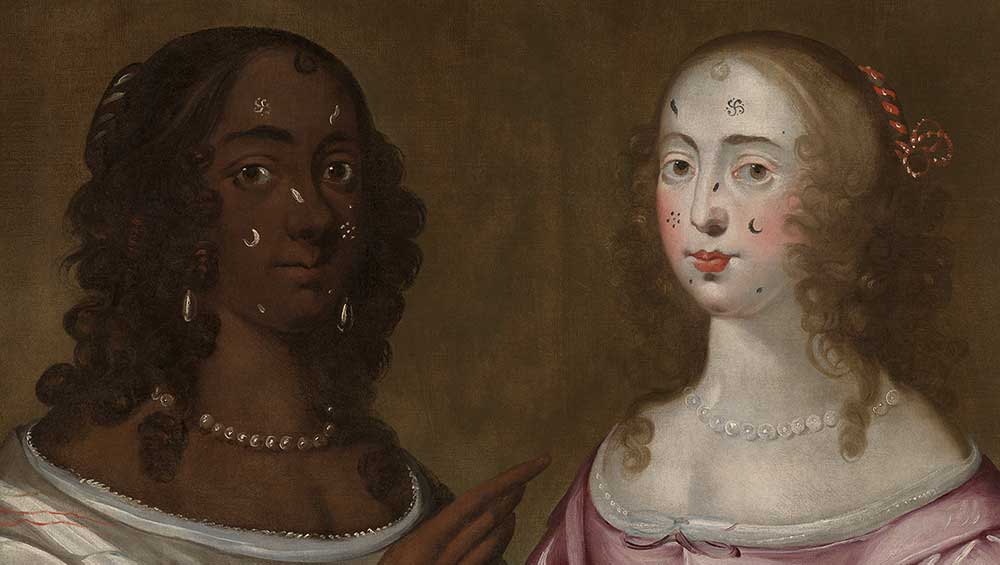
Unknown artist, Two Women Wearing Cosmetic Patches, c1655 (detail). Oil on canvas, Compton Verney Art Gallery and Park, Warwickshire, UK.
Compton Verney, Warwickshire
21 November 2024 – November 2026
by ANNA McNAY
It may seem strange to want to “review” a single painting, but there is more than enough to say about this work to warrant it. It is a question of knowing where to begin.
Two Women Wearing Cosmetic Patches (c1655) depicts what it says it does: two women (one Black, one white), dressed and styled almost identically (even to the matching kiss curls), facing towards one another and the viewers. Oh, and wearing cosmetic patches, of course! In the 17th century, such patches comprised small pieces of (usually) silk, velvet, satin or leather, cut into a shape and glued on to the face with mastic. Circles were popular, but other shapes were also used – commonly stars or moons, as can be seen in this painting, along with some even more intricate spirals. The white woman, we can see, is not just wearing patches but also makeup. At the very least, she has on some blusher and lipstick, and probably also an underlayer of white face powder or paint. This, writes Janet Couloute in an essay for Art UK, was enough, before we even get on to the patches, to:“[fuel] patriarchal concerns about its ability to render white skin unreadable, masking women’s true nature. Women who wore cosmetics were castigated as degenerate and barbarous.”1
But what makes this painting so unusual is the seeming equality between the two women, when one of them is Black. As Jane Simpkiss, a curator at Compton Verney, explains, in her essay accompanying the exhibition: “[T]he painting was made during the Protectorate of Oliver Cromwell, only a few years after English society had been turned upside-down with the execution of Charles I and abolition of the monarchy in 1649. […] Most paintings which include Black and white sitters in the 17th and 18th centuries make the inequality between the individuals stark.”2 Indeed, usually the white aristocratic sitter is the focal point of the painting, with the Black figure, most likely an attendant, portrayed smaller and often looking up into the face of their mistress. It is only recently that museums have begun referring to there being two sitters in portraits such as these, with historic titles usually referencing only the existence of the white sitter.
Both Sir Peter Lely and Pierre Mignard the Elder, celebrated portrait painters of the era, associated their Black sitters with accessories that made them appear “exotic”, such as pearls, coral and seashells. They were thus effectively reduced, Simpkiss suggests, to being merely another symbol of luxury. While both sitters in Two Women are wearing fashionably cut dresses and pearl necklaces, only the Black woman has pearl earrings. Marjorie H Morgan, in Art UK, writes: “The juxtaposition of the creamy white pearls with Black skin is an allegory of empire and colonialism. The contrast of the light, white objects and dark-skinned people draws the viewers’ eye towards the central image of European whiteness, and apparent cultural refinement.”3
In addition to this, the dress of the Black woman in our picture is striped – another common device used to indicate “otherness” and “exoticism” in the European visual tradition, as evidenced by Titian’s painting Diana and Actaeon (1556-59), made a century earlier, in which the Black attendant is wearing stripes and a pearl earring. (Titian’s earlier portrait of Laura Dianti,1520-25, is believed to be the first portrait to include the depiction of a Black page.)4 Writing about the representation of gypsies in the 15th century, the art historian Erwin Pokorny likewise defines a “distinguishing detail” of their portrayal being the “striped patterns in their garments”. As Pokorny observes, striped textiles did not denote one specific ethnic, religious or cultural group, but they were repeatedly used in 15th- and 16th-century tapestries, drawings, paintings and woodcuts to clothe the diverse range of people that included Arabs, Egyptians, Indians, Muslims and Turks.5 Nevertheless, as the art historian Lucia Olubunmi Momoh notes: “What this painting tells us is that as early as the 1650s, a racial binary had begun to form, and that whiteness was being positioned in opposition to Blackness.”6 The Black woman’s presence seems intended to emphasise the white woman’s sins, by associating her with non-European peoples and customs.
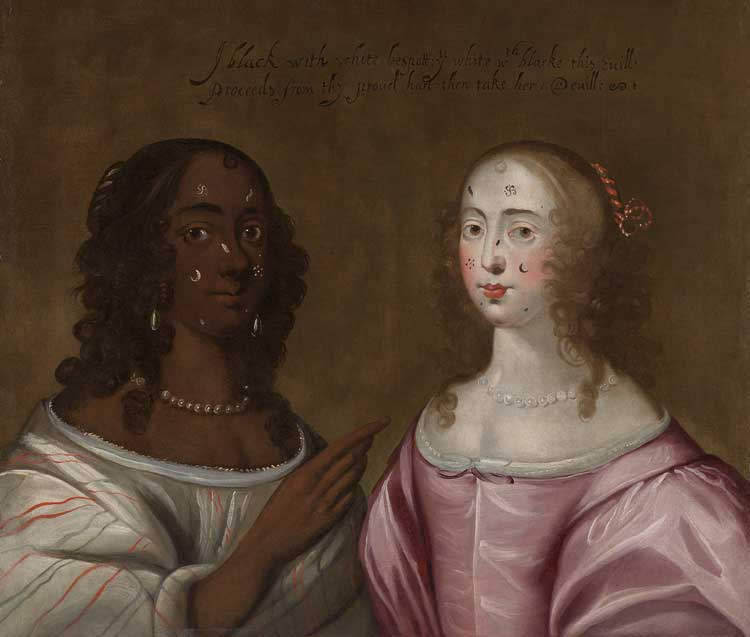
Unknown artist, Two Women Wearing Cosmetic Patches, c1655. Oil on canvas, Compton Verney Art Gallery and Park, Warwickshire, UK.
It should also be noted, however, that, as already mentioned, both women are wearing pearl necklaces, and so the iconography of the pearls alone stands to warn against vanity. This hypothesis is supported by paintings such as David Teniers’ Allegory of Wisdom Triumphing over Vanity (Faith) (1650-90), in which the woman is white. Our white woman is thus rendered three-times cursed: she is wearing makeup, cosmetic patches and pearls.
Crucially for its interpretation, Two Women bears an inscription across the top of the canvas, which reads: I black with white bespott: y[o]u white w[i]th blacke this Evill / proceeds from thy proud hart, then take her: Devill. This strongly suggests that the painting is not a double portrait, but a picture with a moral message, which falls into the category of morality painting or genre painting, rendering the depicted women types rather than individuals. The painting should remind viewers that sinful behaviour leads to the devil, and it should exhort them to seek salvation while there is still time. While both women here are condemned for their use of cosmetic patches, the artist – through the voice of the Black woman (her hand gesture indicates that it is she who is speaking) – particularly criticises the sinful and vain white woman, invoking the devil to take her away.
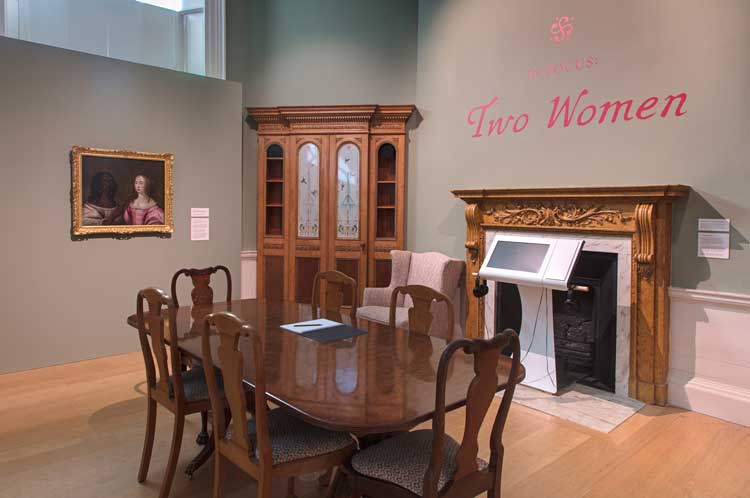
Two Women Wearing Cosmetic Patches, installation view, Compton Verney, Warwickshire, 2024. Image courtesy of Compton Verney.
If the purpose of the painting was to be a moral lesson, then the question arises: who might it have been painted for? “That’s the million-dollar question,” laughs Simpkiss. “The straightforward answer is that we still don’t know.” It is not known, with any certainty, who the artist was either. That said, researchers at the Yale Center for British Art, in New Haven, Connecticut, who conserved, analysed and undertook research into this painting as part of a broader initiative to understand how artists in England in the 16th and 17th centuries used paint to depict various complexions, have put forward a fairly robust hypothesis. They believe that the work may have been commissioned by Lord Kenyon for his wife, Alice Rigby. (It remained in the possession of their descendants until it went to auction in 2021.) Simpkiss explains: “There’s been some discussion that this was perhaps intended as something for Alice to look to when thinking about her moral position and how she needed to be a good influence on the household. As the woman of the house, she would have been responsible for the moral compass of all the people who worked for her, particularly the housemaids. There has been some discussion that it might have hung in her bedroom, so that, while she was at her toilette, getting ready for the day, she might have looked on it to think about how she was going to prepare herself for the day, both physically, but also spiritually. Ultimately, however, we are still not entirely sure as to why the painting was made.”7
Another twist in the tale of Two Women is that there might potentially be a similar, related painting, whose current whereabouts is unknown. In 1949, the then Lord Kenyon wrote a letter to Country Life magazine asking for help in understanding “this curious picture that has hung here for many years, but of which I know of no real explanation”.In response, Baron Leigh, of Stoneleigh Abbey in Warwickshire, replied describing and enclosing a photograph of a similar painting from his collection. This work likewise seemed to condemn vanity, depicting a skeleton holding an arrow above the heart of a white woman wearing almost identical patches to our own. It also bears a similar inscription: Repent; Tomorrow; Tomorrow Madam is another day, It is none of yours. You must to night away. Should these two paintings prove to have formed part of a series of morality paintings, the substitution of a skeleton for the Black woman strongly suggests the interpretation of the Black woman herself as death or the devil, leading the white woman astray.8
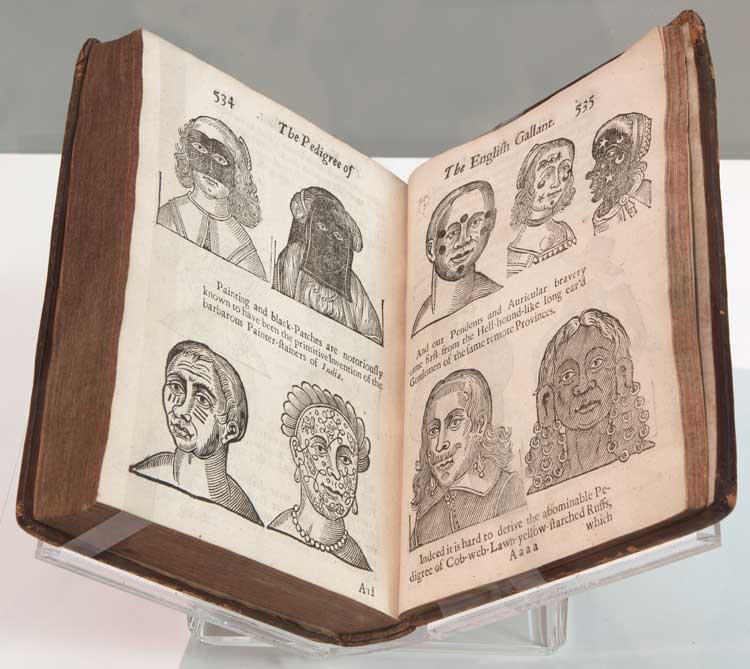
Two Women Wearing Cosmetic Patches, installation view, Compton Verney, Warwickshire, 2024. Image courtesy of Compton Verney.
Furthermore, Edward Town, assistant curator of paintings and sculpture at the Yale Center for British Art, argues that, in our Two Women, the words spoken by the Black woman are a clever set of juxtaposed opposites – I black with white bespot, you white with black. This, Town says, is opposition for opposition’s sake and rhetorical impact, “a piece of preposterous inversion akin to witchcraft itself, which, in western culture, is the most extreme example of oppositionalism”. Before her marriage, Rigby lived with her grandmother in the shadow of Pendle Hill, Lancashire, an area notorious for the eponymous witch trials. “It would make sense, therefore,” Town continues, “that the painting came from the crucible of accusations of black magic and witchcraft in Lancashire, made from a family involved in the persecution of witches.”9
The researchers at the Yale Center for British Art have also suggested a potential artist for the work: Jerome Hesketh (active 1647-66). Hesketh came from the Ribble Valley, the same remote part of Lancashire as the Kenyon and Rigby families, suggesting there could have been a connection. Catholicism was outlawed during the interregnum period, but Hesketh, who had originally trained as a Catholic priest, went from one Catholic house of Lancashire to the next, secretly performing mass, and painting portraits as his cover. The Kenyon family, as you might have guessed, was also Catholic.
With its significant interest in the painting, the Yale Center for British Art had hoped to buy it, until the UK government placed an export stop on the work, primarily because of the “highly unusual” depiction of a Black female sitter in a painting from the period. Simpkiss continues: “We [Compton Verney] were approached as to whether or not we were somewhere that wanted to acquire it, and we thought that it would fit very well with our collections. We have a portrait collection, and we have a very strong 17th-century art collection, so it felt like a good fit for us.”10 The venue’s bids were successful, and the picture was purchased with support from the National Heritage Memorial Fund and the Arts Council England/V&A Purchase Grant Fund, along with Compton Verney’s own collections settlement. Thankfully, Compton Verney still permitted the painting to travel to New Haven for the research project and technical analysis undertaken by conservators from the Yale Center for British Art and conservation scientists from Yale’s Institute for the Preservation of Cultural Heritage.
The technical analysis included X-ray fluorescence scanning, which has offered some further fascinating insights. Jessica David, Senior Paintings Conservator at the Yale Center for British Art, explains how painting manuals of the period made recommendations on how to render different flesh tones. For white sitters, they suggested the synthetic pigments of red vermilion, for rosy lips and cheeks, and blue smalt, for a cool luminosity in the complexion. For darker-toned sitters, manuals recommended natural earth pigments, such as ochres and brown umber. The X-rays of Two Women, however, picked up evidence of mercury in the paint used for the skin of the Black woman, and mercury is a component of vermilion. The white woman, conversely, has evidence of quantities of lead around her eyes. This is a component of lead white, thus showing the painter to have strayed from the manual’s recommendations in the painting of both women.11 Town explains: “The techniques seen in this painting suggest that the artist was not aware of contemporary literature on how to paint various skin tones. In turn, this suggests that the artist may have trained outside of London, which, during this period, was the major artistic centre in England.” This suggestion of the artist behind the painting being an outsider or self-taught in turn provided another reason why the work would be well-homed at Compton Verney, a venue boasting a significant collection of British folk art.
The painting is on display in Compton Verney’s women’s library. “We wanted to make sure it had its own space where we could really talk about it and look into the research that had been done in depth,” explains Simpkiss. “We put it in our women’s library space, where it can be a focal point. Then we were able to bring in the two books which provide contextual evidence so that visitors can better understand the painting.”
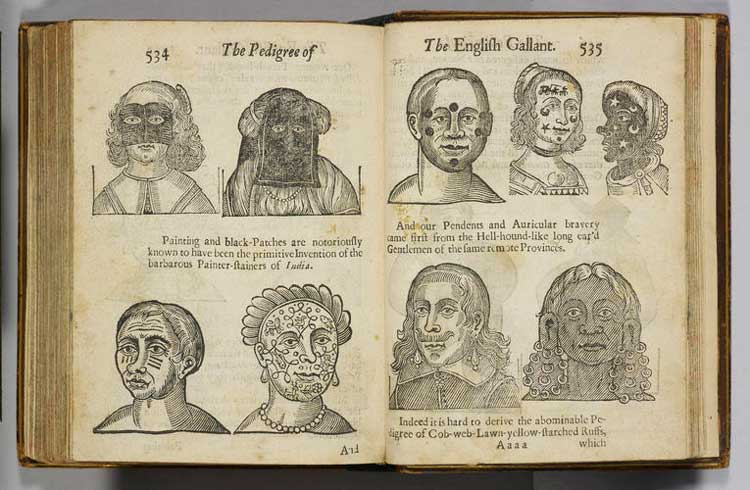
John Bulwer, Anthropometamorphosis: man transformed,1653. Image courtesy of Compton Verney.
These two books, on loan from Trinity College, Cambridge, are John Bulwer’s Anthrometamorphosis: the man transform’d or, the artificiall changeling and Francis Hawkins’ A discourse upon some innovations of habits and dressings against powdring of hair, Naked-Breasts, Black Spots and other unseemly Customes (both 1653). Both books bear illustrations that are strikingly similar to the painting, and they give context to the potential reason for its creation. Bulwer’s book is one of the first on body art and bodily mutilation. It comprises a mix of practical research and stories, and it purports to describe the methods used by people around the world to amend their appearance, from tattooing and body painting to piercing, scarification and artificial cranial deformation (head-binding). It was among the most popular of Bulwer’s books on the human body, and it was liberally illustrated with woodcuts. The text was, of course, coloured by the author’s opinion that body art is a disfigurement of the perfect body created by God. A woodcut print bearing a strong similarity to Two Women appears twice as an illustration in the text referring to cosmetic patches. Bulwer links this fashion to the customs of “barbarous nations” and describes the practice of wearing them as “odious” and “senseless”. The Black woman in the woodcut is racially caricatured with a prominent chin and nose and a wide forehead.
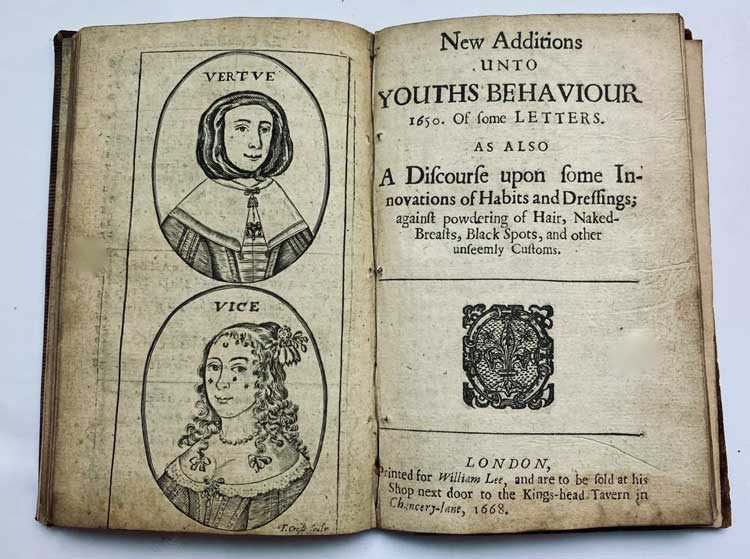
Francis Hawkins 1628-1681. New Additions Unto Youths Behaviour, 1663. Image courtesy of Compton Verney.
Hawkins’ book, on the other hand, offers a simplified version of a set of rules of civility composed by French Jesuits in 1595 (and later copied out by the 14-year-old George Washington in his schoolbook). The rules focus on self-respect and respect for others through details of etiquette. They offer advice on issues such as how to dress, walk, eat in public, and address one’s superiors. Opposite the title page for part two of the work, an illustration contrasts the unadorned face of a woman in puritan dress with a woman wearing patches and a fashionable low-cut dress. The women are labelled “Virtue” and “Vice” respectively. The text criticises the fashion for patches as “an apish trick”, but it doesn’t condemn all cosmetics, offering that modest use might act as an “imbellishment a Woman bestows on her own Beauty”. This distinction could be due to the sinister connotations of patches with, for example, as Town explained above, witchcraft, or, as Simpkiss further notes in her essay, their potential astrological significance. Even their medical use carried negative connotations, with their being used to cover blemishes or scars, typically resulting from smallpox or venereal diseases such as syphilis. As plasters, they could hold a whole range of “medical” concoctions against the wearer’s cheek or temple, leeching out the corrupted humors from beneath.12
.jpg)
Detail from John Bulwer 1606-1656. Anthropometamorphosis: man transformed,1653. Image courtesy of Compton Verney.
Alongside the painting and the books, visitors to Compton Verney are also able to watch the short video, Two Women Wearing Cosmetic Patches: A Research Collaboration, made by the Yale Center for British Art, presenting some of their findings. “The first phase of the display,” Simpkiss says, “looks at the research that has already been done on the painting and its context in the 17th century. Then we’re hoping that we’ll have continued phases in the display where we will bring in other voices to talk about the painting and what it means in an art gallery in the 21st century.”13 By this, Simpkiss is referring to plans afoot to involve contemporary artists and community groups. And it is to Simpkiss that I turn for a wonderful closing sentiment, as she expressed it at the close of a Yale Center for British Art symposium on the painting: “It might be a slightly heretical thing to say as an art historian, but there’s the painting that exists in its full historical context, […] and all that entails, and how we look at it as art historians […]. But it’s also just an image. And I think you can look at that image, and you can take from it as a visitor whatever you want to take from it. There’s nobody stopping you from looking at it and thinking something completely different, or even just having it spark a particular thought, or how one of the women might look to you. Maybe it’s not how the artist intended, but that doesn’t stop it from meaning something to you. And I think that that’s where there is value in non-art historical voices talking about the painting.”14
So, having read to the end of this review-cum-essay, presenting a lot of information about the 17th-century context of the painting and some suppositions about its creation, you now have two years in which to put all that out of your mind, go and see the painting in the flesh, and make up your own meaning and interpretation. I would simply love to read the visitors’ book at the end of this period.
References
1. Beyond the pale: blushing and whiteness in 18th-century portraits of women by Janet Couloute, Art UK, 24 April 2024.
2. In Focus: Two Women Wearing Cosmetic Patches by Jane Simpkiss, curator, Compton Verney, 2024.
3. The Boy with the Pearl Earring: the Decorative Art of Slavery by Marjorie H Morgan, Art UK, 30 March 2022.
4. Ad-dressing Conventions: Clothing, Gender and Race in Two Women Wearing Cosmetic Patches by Jennifer Wu, adjunct professorial lecturer, American University, in Panel 1 – Women, Dress and Morality, at A Puritan Picture: Vanity, Morality, and Race in 17th-Century Britain by the Yale Center for British Art, film of one-day symposium, 27 September 2024.
5. Striped Cloth: Morality, Politics and Gender in Interregnum England by Jemma Field, associate director of research, Yale Center for British Art, in Panel 1 – Women, Dress and Morality, at A Puritan Picture: Vanity, Morality, and Race in 17th-Century Britain by the Yale Center for British Art, film of one-day symposium, 27 September 2024.
6. Two Women Wearing Cosmetic Patches: A Research Collaboration by the Yale Center for British Art, short film, 26 September 2024.
7. Interview with Jane Simpkiss by Anna McNay, 17 January 2025.
8. Information provided in the press release to accompany the display.
9. A Painter for a Puritan Picture? by Edward Town, assistant curator of paintings and sculpture, Yale Center for British Art, opening talk at A Puritan Picture: Vanity, Morality, and Race in 17th-Century Britain by the Yale Center for British Art, film of one-day symposium, 27 September 2024.
10. Interview with Jane Simpkiss by Anna McNay, 17 January 2025.
11. Jill Burke, professor of Renaissance visual and material cultures, University of Edinburgh, notes that mercury is still used in some skin whiteners, killing off the top level of skin cells. Lead was also commonly used, but thankfully no longer is. Erin Griffey, associate professor, University of Auckland, in the same keynote discussion, adds that, in the 17th century, there were “strong vitriolic attacks specifically on the use of lead and mercury in skincare. So, in a way, these women are physically embodying in paint the materials they should not be using on their skin.” In Cosmetics and Cultures of Beauty, keynote discussion at A Puritan Picture: Vanity, Morality, and Race in 17th-Century Britain by the Yale Center for British Art, film of one-day symposium, 27 September 2024.
12. In our interview (ibid), Simpkiss told me of the different connotations of cosmetic patches when worn by a man. They were sometimes used, for example, to draw attention to a war wound or scar on the face. In such an instance, the wearer would be seen not as vain and full of vice, but as heroic. Double standards existed, it would seem, even 400 years ago.
13. Interview with Jane Simpkiss by Anna McNay, 17 January 2025.
14. Exhibiting the Painting, closing discussion, at A Puritan Picture: Vanity, Morality, and Race in 17th-Century Britain by the Yale Center for British Art, film of one-day symposium, 27 September 2024.